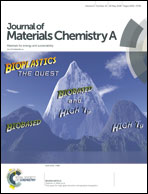Environmentally sustainable, fluorine-free and waterproof breathable PDMS/PS nanofibrous membranes for carbon dioxide capture
Abstract
Membrane contactors are one of many CO2 capture techniques, and they combine chemical absorption and membrane separation. A hydrophobic membrane with high porosity, i.e., a waterproof breathable membrane, is necessary in the CO2 absorption process of membrane contactors. Fluorinated hydrophobic membranes are commonly used in the CO2 absorption process of membrane contactors. However, fluorinated hydrophobic membranes are toxic and harmful to our environment. Consequently, in this study, environmentally friendly, fluorine-free and waterproof breathable polydimethylsiloxane (PDMS)/polystyrene (PS) nanofibrous membranes with a high porosity of 89% are successfully fabricated using an electrospinning process. Compared with pristine PS nanofibrous membranes, PDMS doping in PS nanofibrous membranes successfully prevents liquid droplets from adhering on their surfaces, resulting in the successful fabrication of an anti-wetting membrane surface. The CO2 absorption flux of the as-prepared PDMS/PS nanofibrous membrane is approximately 1.85 mmol m−2 s−1, which is comparable with other previously reported membranes. Furthermore, the fluorine-free hydrophobic PDMS/PS nanofibrous membranes exhibited not only durability but also reusability. As a result, the environmentally friendly, fluorine-free and waterproof breathable PDMS/PS nanofibrous membrane is promising for use in large-scale CO2 absorption applications, such as in membrane contactors for post-combustion CO2 capture in power plants.



 Please wait while we load your content...
Please wait while we load your content...